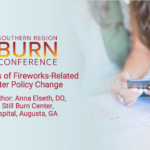Abstract | March 2, 2021
Characteristics of Fireworks-Related Injuries After Policy Change
Learning Objectives
- To compare and discuss the severity of fireworks injuries pre and post change in policy for patients treated at a large regional referral burn center in Georgia;
- To demonstrate the level of resources and care required to care for fireworks injuries sustained after liberalization of fireworks use in GA.
Introduction: In 2015, Georgia legalized the sale of all commercial fireworks to the general public. The previous policy limited fireworks to low-impact pyrotechnics only, such as sparklers. As states have loosened fireworks restrictions, the American Pyrotechnics Association has reported a decline in fireworkrelated accidents. However, they do not comment on the severity of the accidents. Since the liberalization of fireworks laws in Georgia in 2015, there has not been a study to determine if there has been a change to the number and severity of injuries, specifically burns, that fireworks consumers in Georgia sustain during holiday periods.
Methods: We performed a retrospective chart review of patients admitted between July 3-7 and December 30-January 3, 2012-2019. Data collected included age, gender, severity and location of burn, loss of limb or eyesight, length of stay, complications, and non-burn injuries.
Results: Prior to July 2015, most patients required only cadaver therapy to assist in healing of their injuries. After the restrictions on commercial fireworks were relaxed, there was a 260% increase in the number of Georgia residents injured (p=0.04), though intensive care length of stay was not significant (p=0.25) and total body surface area burn remained similar (p=0.79). The number of OR visits increased for all comers (333% increase, 33 vs 143, p<0.0001), this was also demonstrated in patients who were Georgia residents (850% increase, 6 57 vs, p=0.016). Patients with facial injuries required specialized products such as amnion (p<0.01). The number of hand injuries remained the same, but the therapy required after the policy change was dramatically different. While the number of injuries was not significantly increased, injuries sustained were much more severe.
Conclusions: After the policy change, Georgia residents were injured more frequently and required more trips to the OR. All patients had more severe injuries requiring digit amputations, complex tendon and neurovascular repairs, multiple skin grafts, and advanced facial burn products. Despite the fact that the number of injuries was not significant, the increase in severity of injuries demonstrates that the sale of all commercial fireworks may not be in the best interest of Georgia residents.
References and Resources
- House bill 110
- Fireworks-related Injury Rates, 1976-2018; American Pyrotechnics Association, 2019.
- Canner JK, Hairder AH, Selvarajah S, Hui X, Wang H, Efron DT, Haut ER, Velopulos CG, Schwartz DA, Chi A, Schneider EB. US emergency department visits for fireworks injuries, 2006-2010. J Surg Res. 2014 Jul;190(1): 305-11.
- Stahlman S, Taubman SB. Fireworks injuries, active component, U.S. Armed Forces, 2008-2017. MSMR. 2018 Sep;25(9):25-27.
- Fireworks-Related Deaths, Emergency Department-Treated Injuries, and Enforcement Activities During 2018: 2018 Fireworks Annual Report.

